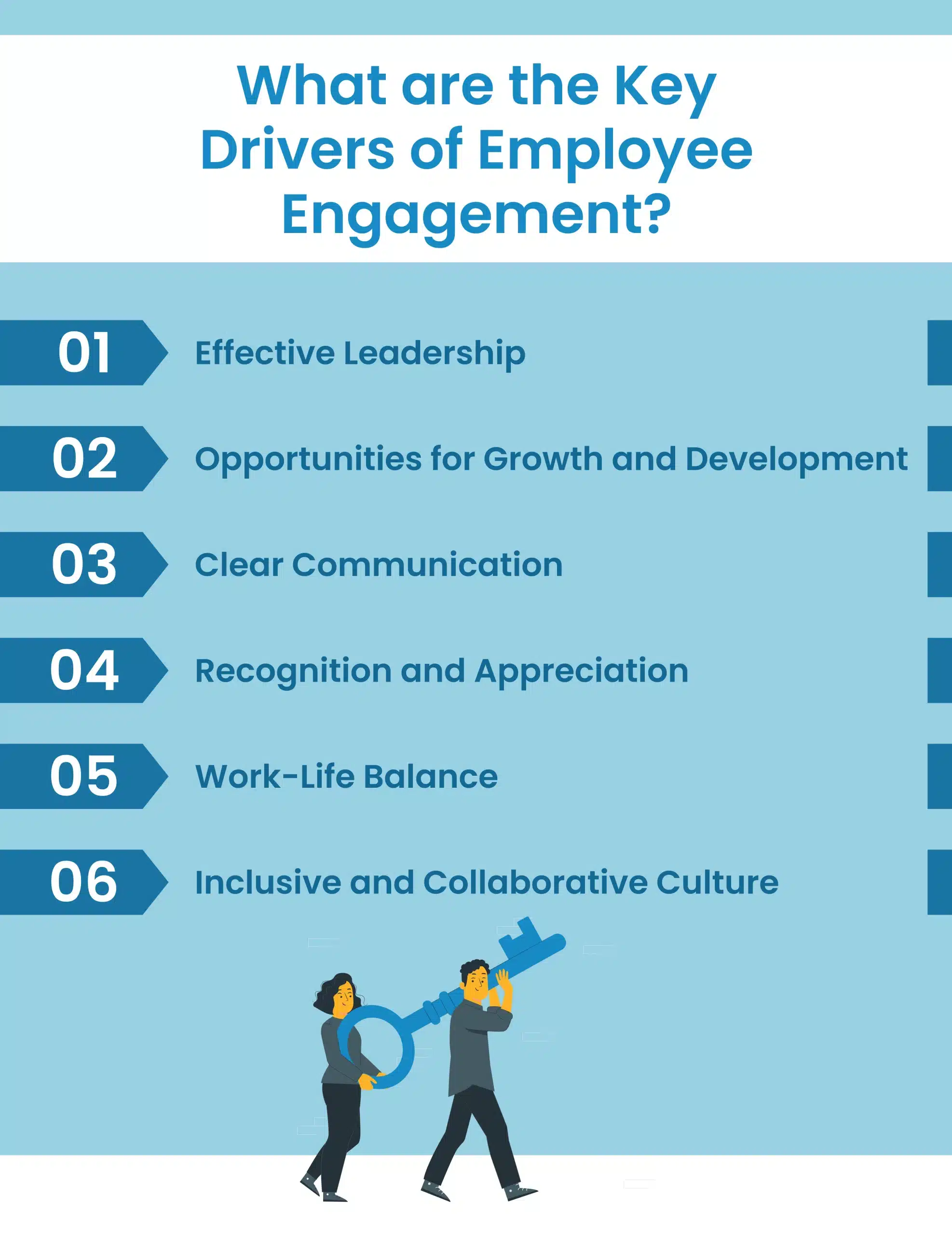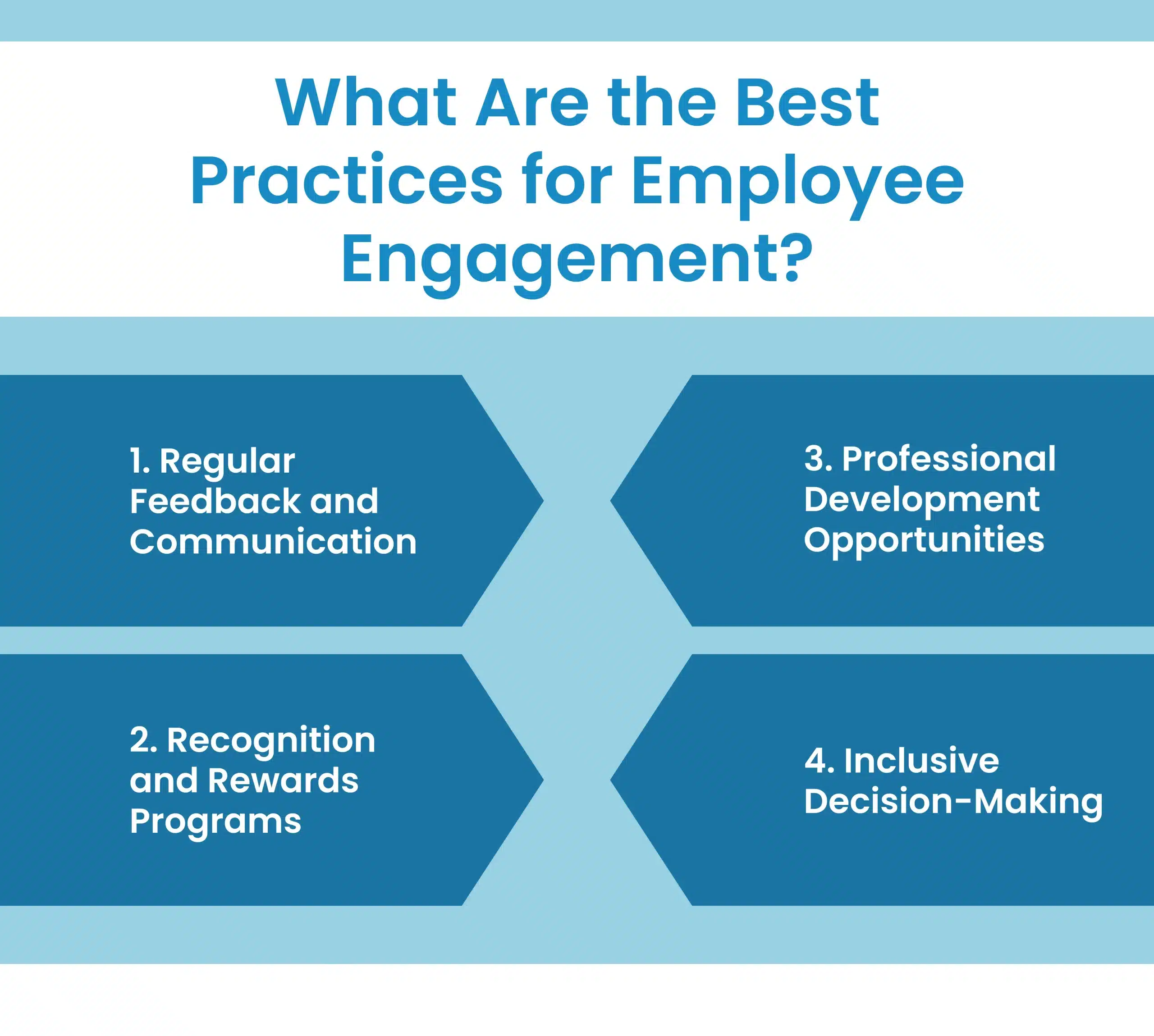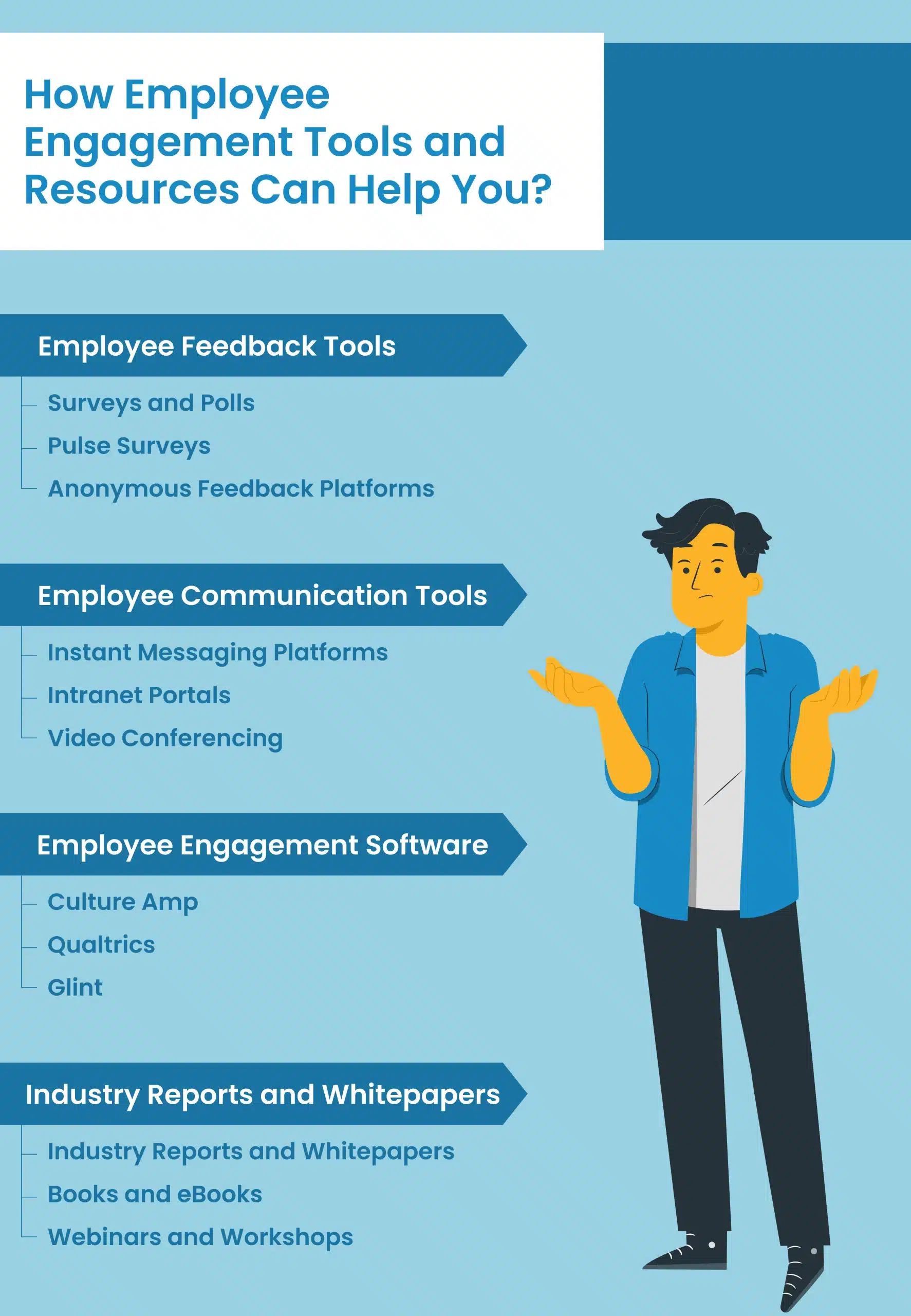Table of content
Early in my career, I worked for a company that didn’t prioritize engagement. The turnover rate in the company was high, morale was low, and productivity suffered. Clearly, disengaged employees weren’t just affecting the bottom line but impacting the organization’s overall health. However, in stark contrast, I later joined a company that truly understood the benefits of employee engagement.
At this new company, they invested significantly in their people, actively listened to their feedback, and celebrated their successes. The results were transformative. Employees were not just happier and more motivated but also more committed to the company’s goals.
In this blog, we’ll explore why every organization, regardless of size or industry, should prioritize employee engagement. Let’s get started!
Understanding The Basics of Employee Engagement
Let’s discuss the core elements that drive employee engagement to understand what it truly means, the driving factor and current trends. This section will provide a solid foundation for enhancing employee engagement within your organization.
What is Employee Engagement?
Employee engagement is the emotional commitment and dedication employees have toward their organization. It goes beyond job satisfaction and drives productivity, customer satisfaction, and employee retention. Effective communication, growth opportunities, and a positive work environment foster engagement. Eventually, it leads to a motivated, high-performing workforce and overall business success.
Why is Employee Engagement Important for an Organization?
Engaged employees are self-motivated and productive, even when working remotely. With higher expectations, they seek meaningful work, growth opportunities, and a positive work environment. Meeting these expectations is crucial for attracting and retaining top talent, fostering a motivated, productive, and satisfied workforce, and ultimately leading to improved organizational performance.
What are the Key Drivers of Employee Engagement?
The key drivers of employee engagement can be categorized into several factors that influence how employees feel about their work and the organization. These drivers include:
- Effective Leadership: Strong and supportive leadership fosters employee engagement. Leaders who are transparent, accessible, and empathetic create a sense of trust and confidence among employees, leading to higher engagement levels.
- Opportunities for Growth and Development: Employees value opportunities to learn new skills, take on challenging projects, and advance in their careers. Organizations prioritizing professional development and career growth tend to experience higher levels of employee engagement.
- Clear Communication: Open and transparent communication from management helps employees understand the company’s goals, strategies, and expectations. Employees who feel informed and involved are more likely to be engaged in their work.
- Recognition and Appreciation: Regular recognition and appreciation for employees’ contributions can significantly impact their engagement. Acknowledging and rewarding their efforts fosters a positive work environment and reinforces a sense of value within the organization.
- Work-Life Balance: Organizations that support work-life balance through flexible work arrangements, wellness programs, and time-off policies are committed to their employees’ well-being, ultimately contributing to higher engagement levels.
- Inclusive and Collaborative Culture: Employees thrive in environments where they feel included, valued, and part of a supportive team. Cultivating a culture of collaboration, diversity, and inclusion can boost employee morale and engagement.
What are the Latest Employee Engagement Trends?
Employee engagement trends are constantly evolving to meet the changing needs of the workforce. Staying up to date with the latest trends is crucial for organizations aiming to create a positive and productive work environment. Let’s take a closer look to understand:
- Technology Integration: One of the latest employee engagement trends is the integration of technology to enhance communication and collaboration. From employee engagement tools to virtual employee engagement activities, technology plays a crucial role in keeping employees connected and motivated.
- Focus on Well-being: Another notable trend in employee engagement is the increased focus on employee well-being. Organizations are recognizing the importance of supporting their employees’ physical, mental, and emotional health to drive engagement and retention.
- Flexible Work Options: Flexible work arrangements, including remote work and flexible hours, have become a prominent employee engagement trends. Providing employees with the flexibility to balance work and personal life is essential for fostering a positive work environment.
- Personalized Employee Engagement Strategies: Customizing engagement strategies to meet the unique needs of individual employees is gaining traction as a leading trend. Recognizing that one size does not fit all, organizations are tailoring their approach to employee engagement based on diverse preferences and motivations.
What Are the Best Practices for Employee Engagement?
Let’s explore the best practices for employee engagement and discuss effective strategies that can transform your workplace. You can implement these practices to enhance employee engagement in your organization.
- Regular Feedback and Communication: Establishing a culture of continuous feedback is crucial for better employee engagement. They need to know how they are performing and where they can improve. Regular one-on-one meetings and open communication channels help in building trust and understanding.
- Recognition and Rewards Programs: Recognizing and rewarding employees for their hard work and achievements is one of the most powerful ways to boost engagement. Implementing a structured recognition program that celebrates big and small successes can significantly enhance morale and motivation.
- Professional Development Opportunities: Providing employees with opportunities for learning and growth is essential. This can include training programs, workshops, mentorship, and clear career advancement paths. Employees who see a future within the organization are more likely to stay engaged and committed.
- Inclusive Decision-Making: Involving employees in decision-making processes, especially those that affect their work, can lead to greater buy-in and a sense of ownership. This practice improves engagement and brings diverse perspectives to the table.
How to Create an Effective Employee Engagement Strategies
Undoubtedly, implementing best practices requires effective employee engagement strategies that can significantly impact the productivity and well-being of your workforce. Let’s see how:
- Creating a Positive Work Environment: A positive and supportive work environment can increase Employee Engagement. This includes everything from a comfortable physical workspace to a culture of respect and collaboration. Encouraging teamwork and fostering a sense of community can make employees feel more connected and engaged.
- Implementing Flexible Work Arrangements: Offering flexible work arrangements, such as remote work options or flexible hours, can help you increase employee engagement and maintain a healthy work-life balance. This flexibility shows the organization values their well-being, leading to higher engagement levels.
- Employee Wellness Programs: Investing in employee wellness programs, including mental health support, fitness initiatives, and stress management resources, demonstrates a commitment to employee well-being. Healthy employees are more likely to be engaged and productive.
- Leadership Development: Developing strong leaders within the organization is crucial for driving engagement. Effective leaders inspire, motivate, and engage their teams by setting a positive example and providing clear direction and support.
How Employee Engagement Tools and Resources Can Help You?
This section will explore a few employee engagement tools and resources that can help foster solid engagement. Let’s get started!
Employee Feedback Tools
Employee feedback tools are essential for gaining insights into employee sentiments and identifying areas for improvement. These tools allow employees to provide honest feedback on various aspects of their work experience. Some popular employee feedback tools include:
- Surveys and Polls: Regular surveys and polls can help gauge employee satisfaction and identify trends over time. Tools like SurveyMonkey and Google Forms are user-friendly options for collecting feedback.
- Pulse Surveys: These are short, frequent surveys that help monitor employee engagement levels in real time. Tools like TINYpulse and Officevibe offer pulse survey features that provide quick insights into employee morale.
- Anonymous Feedback Platforms: Platforms like 15Five and Peakon allow employees to provide anonymous feedback, ensuring they feel safe to express their true opinions without fear of repercussions.
Employee Communication Tools
Effective communication is a key driver of employee engagement. Employee communication tools help bridge communication gaps and ensure everyone is aligned with the organization’s goals. Some practical communication tools include:
- Instant Messaging Platforms: Tools like Slack and Microsoft Teams facilitate real-time communication and collaboration among team members, making it easier to stay connected and informed.
- Intranet Portals: An intranet portal is a central hub for all company communications, resources, and updates. Platforms like SharePoint and Jostle help streamline communication and keep employees informed.
- Video Conferencing: Tools like Zoom and Google Meet are essential for virtual meetings, enabling face-to-face interactions even when working remotely.
Employee Engagement Software
Employee engagement software provides comprehensive solutions for measuring and enhancing engagement through data-driven insights and automated processes. These tools often combine multiple features such as surveys, feedback mechanisms, and analytics. Some popular employee engagement software include:
- Culture Amp: This platform offers powerful analytics and actionable insights to help improve employee engagement and performance.
- Qualtrics: Qualtrics provides extensive survey capabilities and robust analytics to help organizations understand and improve employee engagement.
- Glint: Glint focuses on real-time employee engagement data, providing insights and recommendations to drive engagement strategies.
Employee Engagement Resources
Access to comprehensive employee engagement resources can provide valuable information and best practices for fostering a more engaged workforce. These resources can include:
- Industry Reports and Whitepapers: Reading up on the latest industry reports and whitepapers can provide insights into current engagement trends and effective strategies. Websites like Gallup and Deloitte regularly publish valuable research on employee engagement.
- Books and eBooks: Books such as “Drive” by Daniel H. Pink and “The Employee Experience Advantage” by Jacob Morgan offer in-depth insights and practical advice on fostering engagement.
- Webinars and Workshops: Participating in webinars and workshops can provide practical tips and real-world examples of successful engagement strategies. Platforms like HR.com and LinkedIn Learning offer a variety of webinars on employee engagement topics.
Why Recognition and Appreciation is Necessary for Solid Employee Engagement?
Recognizing and appreciating employees is fundamental to fostering a positive and engaging work environment. Employees who feel valued and appreciated are more motivated, productive, and loyal to the organization. Let’s explore the benefits of employee recognition and share a few creative Employee Appreciation Day ideas:
Benefits of Employee Recognition
Recognizing employees for their hard work and contributions has numerous benefits for both the employees and the organization. Some of the key benefits of employee recognition include:
- Increased Motivation: Regular recognition boosts employees’ motivation and encourages them to maintain high performance. When employees know their efforts are noticed and valued, they are more likely to stay motivated and engaged.
- Enhanced Job Satisfaction: Employees who feel appreciated are more satisfied. This satisfaction can lead to improved morale and a positive workplace atmosphere.
- Higher Retention Rates: Recognized employees are less likely to seek opportunities elsewhere. Organizations can reduce turnover rates and retain top talent by valuing and recognizing their contributions.
- Improved Performance: Recognition fosters a culture of excellence, encouraging employees to strive for better performance. When employees see that their hard work is acknowledged, they are more likely to go above and beyond in their roles.
- Stronger Team Dynamics: Recognizing team achievements can enhance collaboration and teamwork. When employees feel appreciated, they are more likely to support and encourage their colleagues, leading to a more cohesive and productive team.
How to Increase Employee Engagement Through Activities?
Engaging employees goes beyond recognition and appreciation; it involves creating meaningful experiences that foster connection, collaboration, and a sense of belonging. This section will explore some of the best activities to boost employee engagement and create a positive workplace culture.
Best Employee Engagement Activities
- Team Building Events: Organizing team building events can strengthen employee relationships and improve teamwork. Activities such as team outings, sports competitions, or volunteer events encourage collaboration and foster a sense of camaraderie.
- Lunch and Learns: Host regular lunch and learn sessions where employees can gather to learn new skills, share knowledge, or discuss industry trends. These sessions not only promote continuous learning but also encourage networking and engagement.
- Employee Appreciation Events: Beyond Employee Appreciation Day, consider hosting regular yearly appreciation events. These events can include themed parties, BBQs, or casual get-togethers to celebrate milestones and achievements.
- Wellness Challenges: Launch wellness challenges that promote healthy habits among employees. Challenges could include step challenges, mindfulness activities, or fitness competitions. Supporting employee well-being contributes to overall engagement and productivity.
- Cross-Departmental Collaboration: Encourage employees from different departments to collaborate on projects or initiatives. Cross-departmental teams allow employees to learn from each other, share diverse perspectives, and build stronger connections across the organization.
- Skill-Sharing Sessions: Facilitate skill-sharing sessions where employees can teach each other skills outside their usual roles. This promotes personal growth and strengthens teamwork and mutual respect among colleagues.
- Social Events: Host social events such as happy hours, game nights, or holiday parties where employees can relax and socialize outside of work. These informal gatherings help build friendships and a sense of community within the organization.
- Volunteer Opportunities: Organize volunteer activities where employees can give back to their community. Volunteering fosters a sense of purpose and fulfilment while demonstrating the organization’s commitment to social responsibility.
- Employee-led Initiatives: Encourage employees to propose and lead their engagement initiatives. Whether starting a book club, organizing a charity drive, or launching a sustainability project, empowering employees to take ownership boosts engagement and morale.
- Feedback Sessions and Idea Sharing: Hold regular feedback sessions or idea-sharing forums where employees can voice their opinions, provide suggestions for improvement, and contribute to decision-making processes. Demonstrating that their input matters increases engagement and fosters a culture of transparency.
Conclusion
Understanding the importance of employee engagement reveals it’s more than just making employees happy at work. It’s crucial for a company’s success, impacting productivity, how long employees stay, and overall performance.
Engaged employees are more productive and contribute positively to teamwork and company culture. By investing in things like good communication, growth opportunities, and a supportive work environment, companies can build a motivated and ready workforce.
Recognizing employees’ achievements and creating engaging activities are important steps in boosting engagement. Whether a small startup or a big company, understanding and using employee engagement strategies are crucial for long-term success in today’s competitive world.
Following the ideas and practices discussed here, companies can create workplaces where employees feel valued, empowered, and motivated to give their best. This leads to growth and success for everyone involved.
Looking to hire the best tech talent for your company? Contact us today and we will help you build your team.



